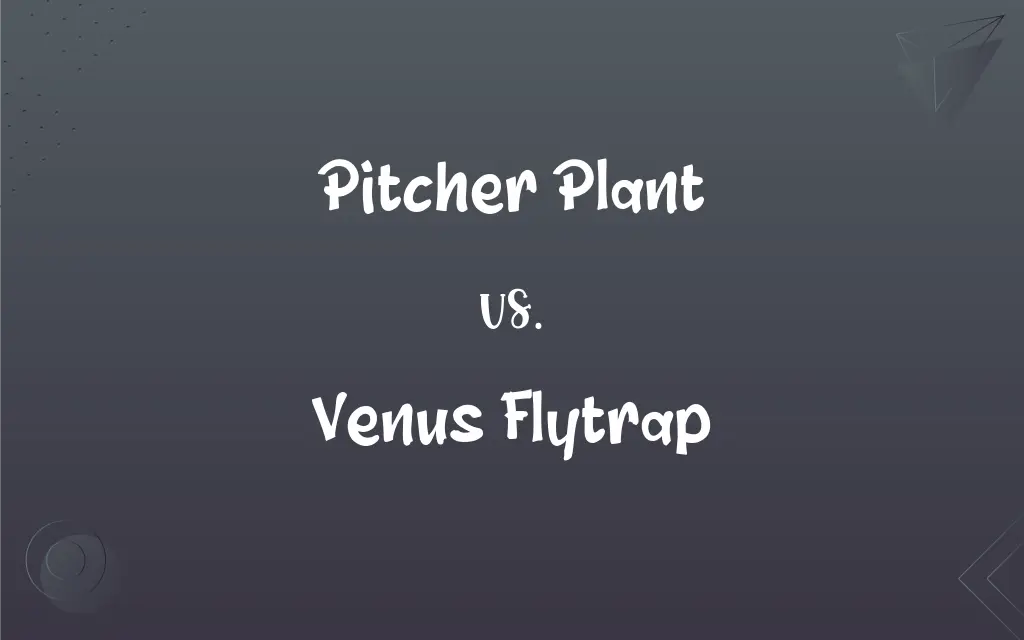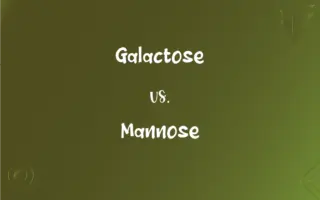Pitcher Plant vs. Venus Flytrap: What's the Difference?
Edited by Aimie Carlson || By Harlon Moss || Published on January 10, 2024
Pitcher plants trap prey in a deep cavity filled with digestive liquid, while Venus flytraps use rapid leaf movements to capture insects.

Key Differences
Pitcher plants, belonging to several genera like Nepenthes and Sarracenia, use a deep, slippery pitfall trap. Venus flytraps, Dionaea muscipula, feature hinged leaves that snap shut when triggered by prey.
In pitcher plants, the trap is a modified leaf forming a deep pool of digestive enzymes. In contrast, Venus flytraps have specialized leaves that rapidly close to trap insects upon stimulation.
The trapping mechanism of pitcher plants relies on a combination of visual and olfactory lures to attract prey. Venus flytraps employ sensitive trigger hairs on their inner surfaces to detect and capture prey.
Pitcher plants are found in a variety of habitats, often in nutrient-poor environments, relying on their trapping ability for nutrition. Venus flytraps are native to subtropical wetlands in North and South Carolina, with similar nutritional needs.
The digestive process in pitcher plants can take days to weeks, slowly breaking down prey. Venus flytraps digest their prey rapidly, usually within a week after trapping.
ADVERTISEMENT
Comparison Chart
Trap Type
Deep cavity with digestive liquid
Rapidly closing hinged leaves
Mechanism
Slippery walls and digestive enzymes
Sensitive trigger hairs and rapid leaf movement
Attraction Method
Visual and olfactory lures
Trigger hairs sensitive to touch
Habitat
Various, often nutrient-poor
Subtropical wetlands in the Carolinas
Digestion Time
Days to weeks
Usually within a week
ADVERTISEMENT
Pitcher Plant and Venus Flytrap Definitions
Pitcher Plant
A pitcher plant is a carnivorous plant with a modified leaf forming a pitfall trap.
The pitcher plant's brightly colored cavity attracted numerous unsuspecting insects.
Venus Flytrap
The digestion process of a Venus flytrap is relatively quick, usually within a week.
Once trapped, an insect in the Venus flytrap is digested in just a few days.
Pitcher Plant
Pitcher plants utilize a deep cavity filled with digestive enzymes to capture prey.
Insects lured into the pitcher plant's trap cannot escape from its slippery walls.
Venus Flytrap
Sensitive trigger hairs on the Venus flytrap's leaves detect and respond to prey.
Tiny hairs inside the Venus flytrap's leaves are key to its effective insect trapping.
Pitcher Plant
The digestion process in pitcher plants involves breaking down prey over several days.
An insect caught in the pitcher plant will be slowly digested over time.
Venus Flytrap
Venus flytraps capture prey using rapid leaf movements triggered by touch.
The slightest touch of an insect sets off the Venus flytrap's snapping mechanism.
Pitcher Plant
Pitcher plants attract their prey using a combination of scent, nectar, and color.
The sweet scent of the pitcher plant's nectar drew in a variety of bugs.
Venus Flytrap
This plant is native to subtropical wetlands and uses insect trapping for nutrition.
The Venus flytrap, found in the Carolinas, supplements its diet with insects.
Pitcher Plant
These plants are adapted to nutrient-poor environments, supplementing their diet with trapped insects.
The pitcher plant thrives in its boggy habitat, feeding on insects for nutrients.
Venus Flytrap
The Venus flytrap is a carnivorous plant with hinged leaves that snap shut to trap insects.
When a fly touched the Venus flytrap's trigger hairs, the leaves quickly closed.
FAQs
How does a pitcher plant trap insects?
Pitcher plants trap insects in a deep cavity lined with slippery walls and digestive enzymes.
What is a Venus flytrap?
A Venus flytrap is a carnivorous plant known for its rapidly closing leaves that trap insects.
Where are pitcher plants typically found?
Pitcher plants are often found in nutrient-poor environments like bogs and wetlands.
What is a pitcher plant?
A pitcher plant is a carnivorous plant with a modified leaf that forms a pitfall trap.
Are Venus flytraps easy to care for?
Venus flytraps require specific conditions like moist soil and high humidity, making them moderately challenging to care for.
How does a Venus flytrap capture prey?
Venus flytraps use sensitive trigger hairs on their leaves to detect and rapidly close around prey.
How fast does a Venus flytrap close?
A Venus flytrap closes rapidly, typically in less than a second, once its trigger hairs are stimulated.
How do pitcher plants digest their prey?
Pitcher plants use enzymes within their trap to slowly break down and absorb nutrients from their prey.
Do pitcher plants produce flowers?
Yes, pitcher plants produce flowers, but they are separate from their insect-trapping leaves.
Can a Venus flytrap harm humans?
No, Venus flytraps are not harmful to humans as their traps are designed for small insects.
How do pitcher plants lure prey?
Pitcher plants use visual and olfactory lures, such as bright colors and sweet nectar, to attract insects.
Can pitcher plants digest human food?
Pitcher plants are adapted to digest insects, not human food, and such feeding can harm the plant.
Do pitcher plants need sunlight?
Yes, pitcher plants require sunlight for photosynthesis, although the amount needed varies by species.
What should I do if my Venus flytrap's trap doesn't open after catching prey?
If a Venus flytrap's trap doesn't open, it's likely digesting its prey, and no action is needed. It will reopen once digestion is complete.
What is the native habitat of Venus flytraps?
Venus flytraps are native to subtropical wetlands, particularly in the Carolinas.
How many times can a Venus flytrap leaf close?
A Venus flytrap leaf can close multiple times, but it typically becomes less effective after 3-4 closures.
Can a Venus flytrap survive without eating insects?
While insects supplement their nutrition, Venus flytraps can survive for periods without insect prey.
Can I feed meat to my Venus flytrap?
Feeding meat to Venus flytraps is not recommended as it can decay and harm the plant.
How long does it take for a pitcher plant to digest insects?
The digestion process in pitcher plants can take several days to weeks, depending on the size of the prey.
Are there different types of pitcher plants?
Yes, there are several genera of pitcher plants, each with unique characteristics and trapping mechanisms.
About Author
Written by
Harlon MossHarlon is a seasoned quality moderator and accomplished content writer for Difference Wiki. An alumnus of the prestigious University of California, he earned his degree in Computer Science. Leveraging his academic background, Harlon brings a meticulous and informed perspective to his work, ensuring content accuracy and excellence.
Edited by
Aimie CarlsonAimie Carlson, holding a master's degree in English literature, is a fervent English language enthusiast. She lends her writing talents to Difference Wiki, a prominent website that specializes in comparisons, offering readers insightful analyses that both captivate and inform.






































































